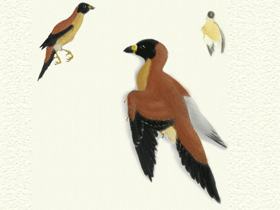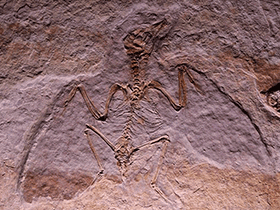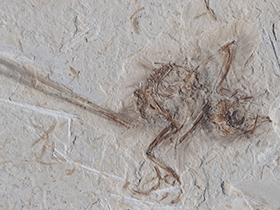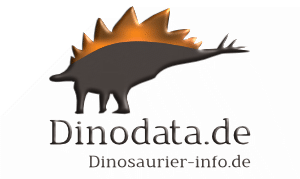FAMILIENLISTE / Enantiornithes

Walker, 1981
Aves Pygostylia Ornithothoraces Enantiornithes
 Avisauridae, Enantiornithes, Enantiornithidae, Euenantiornithes, Longipterygidae, Pengornithidae, Songlingornithidae
Avisauridae, Enantiornithes, Enantiornithidae, Euenantiornithes, Longipterygidae, Pengornithidae, Songlingornithidae
Die Gruppe der Enantiornithes ("Gegenvögel") war die am häufigsten vorkommende im gesamten Mesozoikum und wurde erstmalig 1981 von Cyril Walker beschrieben. Diese Vögel lebten von der oberen bis zur unteren Kreidezeit. Die ersten gefundenen Enantiornithes wurden fälschlicherweise den modernen Vogelgruppen bezogen auf Gobipteryx zugeordnet. Sie wurden von Walker zunächst als eigenständige Untergruppe beschrieben, basierend auf einige Überreste aus späten Kreidezeit des heutigen Argentinien. Seit den 1990er Jahren wurden dann mehr vollständige Exemplare dieser Gruppe entdeckt und diese Funde zeigten, dass einige zuvor beschriebene Vögel wie Iberomesornis, Cathayornis oder auch Sinornis enantiornithe Eigenschaften besaßen.
Der charakteristische Unterschied zwischen den Enantiornithes und allen anderen Vögeln ist die Art der Artikulation zwischen dem Schulterblatt und dem Rabenbein, welches im "normalen" Zustand vollständig umgekehrt ist. Die Enantiornithes unterscheiden sich von den Ornithurae, dazu gehören auch die rezenten Vogelarten, in der Gelenkverbindung zwischen Schulterblatt und Rabenbein. Bei modernen ornithurinen Vögeln liegt am Schulterblatt eine Gelenkpfanne und am Rabenbein ein Gelenkzapfen vor. Im Handgelenk (Carpometacarpus) der Enantiornithes reichte der dritte Mittelhandknochen nach außen über die Länge des zweiten Mittelhandknochens hinaus.

Liaoningornis/ © Alain Beneteau
Die Enantiornithes besaßen lange gebogene Klauen und auch die Proportionen der Zehen lassen vermuten,
dass sie Baumbewohner waren. Manche Formen wie Eocathayornis, Protopteryx und Eoalulavis besaßen einen sogenannten Daumenfittich. Dieser hat die Aufgabe, die Luftströmung über dem Flügel auch bei steilem Anstellwinkel nicht abreißen zu lassen, so dass der Auftrieb erhalten bleibt. Daher dürften die Enantiornithes gegenüber Confuciusornis, Jeholornis und Archaeopteryx bessere Flugeigenschaften besessen haben.
Zu den beschriebenen enantiornithinen Fossilien gehören auch Eier, Embryonen und Jungtiere. Ein enantiornithines Embryo, noch im Eier hockend, ist aus der Yixian Formation in China beschrieben worden. Juvenile Exemplare können durch eine Kombination von Faktoren identifiziert werden: die grobe Textur ihrer Knochenspitzen, eine relativ kleine Brust, große Augen sowie Schädel und Knochen, die noch nicht miteinander verschmolzen sind. Einige Jungtier-Funde besitzen nur einen formalen Namen, darunter auch Liaoxiornis delicatus. Luis Chiappe und seine Kollegen halten die Praxis der Benennung neuer Arten auf Grundlage juveniler Exemplare für nachteilig auf das Studium der Enantiornithes. Es ist ihrer Meinung nach fast unmöglich, eine erwachsene Art aufgrund einer juvenilen Probe zu bestimmen. Daher sind viele Arten mit dem Holotypus eines Jungtieres ein nomen dubium.
Diese Funde zeigen außerdem, dass enantiornithine Jungtiere gut entwickelte Flügelfedern und ein großes Gehirn besaßen. Diese Entwicklung korreliert mit der Entwicklung von Nestflüchtern der heutigen Vögel. Zumindest einige enantiornithine Vögel waren wahrscheinlich nach ein paar Tagen aus dem Ei heraus wesentlich entwickelt, lauf- und möglicherweise auch flugfähig. Dies, zusammen mit der Tatsache, dass die ältesten Linien der modernen Vögel ebenfalls Nestflüchter waren, deutet darauf hin, dass die Eigenschaft des Nestflüchtens eine wesentliche Merkmalsprägung (Plesiomorphie) der Vögel aus der unteren Kreidezeit war. Es wurden Analysen der enantiornithinen Knochengewebestrukturen durchgeführt, um die Wachstumsrate der Tiere zu bestimmen. Eine Studie von Concornis-Knochen zeigt, dass sich das Wachstumsmuster von denen der modernen Vögel unterscheidet: Das Wachstum war für einige Wochen nach dem Schlüpfen schneller - voraussichtlich bis zum flugfähigen Stadium. Die recht kleinen Arten erreichten erst spät die Größe eines Erwachsenen, wahrscheinlich sogar erst mehrere Jahre nach dem Schlüpfen.
 Ornithothoraces
Ornithothoraces
 Enantiornithes
Enantiornithes
. Abavornis
. Alexornis
. Avimaia
. Avisaurus
. Brevirostruavis
.
Castignovolucris
. Catenoleimus
. Cathayornis
. Cerebavis
. Dapingfangornis
. Dunhuangia
. Elektorornis
. Eoalulavis
. Eoenantiornis
. Evgenavis
. Explorornis
. Falcatakely
. Feitianius
. Flexomornis
. Fortipesavis
. Fortunguavis
. Gargantuavis
. Gobipteryx
. Grabauornis
. Iberomesornis
. Imparavis
. Jibeinia
. Junornis
. Kizylkumavis
. Largirostrornis
. Liaoningornis
. Liaoxiornis
. Linyiornis
. Longchengornis
. Martinavis
. Noguerornis
. Otogornis
. Paraprotopteryx
. Protopteryx
. Pterygornis
. Sazavis
. Vescornis
. Yatenavis
. Xianggornis
. Yungavolucris
. Yuornis
-  Avisauridae (Brett-Surman, Paul, 1985)
Avisauridae (Brett-Surman, Paul, 1985)
-. Bauxitornis
-. Mirarce
-. Mystiornis
-. Neuquenornis
-. Soroavisaurus
-- Enantiornithidae
Enantiornithidae
--. Enantiornis (Typ)
--. Nanantius
--- Euenantiornithes
Euenantiornithes
Die Euenantiornithes sind definiert als näher an Sinornis santensis als an Iberomesornis romerali
---. Cerebavis
---. Concornis
---. Cuspirostrisornis
---. Cratoavis
---. Eocathayornis
---. Halimornis
---- Longipterygidae (Zhang, Zhou, Hou, Gu, 2001)
Longipterygidae (Zhang, Zhou, Hou, Gu, 2001)
----. Boluochia
----. Longipteryx
----. Longrostravis
----. Shanweiniao
----. Rapaxavis
----- Pengornithidae (Wang et al., 2014)
Pengornithidae (Wang et al., 2014)
Vögel aus der Gruppe der Pengornithidae waren primitive Enantiornithes. In ihren Kiefern befanden sich viele kleine Zähne und sie besaßen recht stämmige Beine.
-----. Chiappeavis
-----. Eopengornis
-----. Parapengornis
-----. Pengornis
-----. Yuanchuavis
------ Songlingornithidae
Songlingornithidae
------. Piscivoravis
------. Songlingornis
------. Yanornis
------. Yixianornis

© Daniel Bensen

© il_gatto_nero

© Carvalho et al.
Weitere Informationen
Anatomy and Flight Performance of the Early Enantiornithine Bird Protopteryx fengningensis: Information from New Specimens of the Early Cretaceous Huajiying Formation of China / Luis M. Chiappe, Liu Di, Francisco J. Serrano, Zhang Yuguang, Qingjin Meng, 2019 / The Anatomical Record, Volume 303, Issue 4, Special Issue: The Hidden World of Dinosaurs, April 2020, Pages 716-731, https://doi.org/10.1002/ar.24322
/ Luis M. Chiappe, Liu Di, Francisco J. Serrano, Zhang Yuguang, Qingjin Meng, 2019 / The Anatomical Record, Volume 303, Issue 4, Special Issue: The Hidden World of Dinosaurs, April 2020, Pages 716-731, https://doi.org/10.1002/ar.24322
Anatomy of the Early Cretaceous bird Eoenantiornis buhleri (Aves: Enantiornithes) from China / Zhonghe Zhou, Luis M. Chiappe, Fucheng Zhang, 2005 / Canadian Journal of Earth Sciences, 42 (7), pp. 1331–1338
/ Zhonghe Zhou, Luis M. Chiappe, Fucheng Zhang, 2005 / Canadian Journal of Earth Sciences, 42 (7), pp. 1331–1338
Anatomy of the Early Cretaceous enantiornithine bird Rapaxavis pani / Jingmai K. O'Connor, Luis M. Chiappe, Chunling Gao, Bo Zhao, 2011 / Acta Palaeontologica Polonica 56 (3), 2011: 463-475 doi: http://dx.doi.org/10.4202/app.2010.0047 /
/ Jingmai K. O'Connor, Luis M. Chiappe, Chunling Gao, Bo Zhao, 2011 / Acta Palaeontologica Polonica 56 (3), 2011: 463-475 doi: http://dx.doi.org/10.4202/app.2010.0047 /![]() PDF
PDF
A Mesozoic bird from Gondwana preserving feathers / Ismar de Souza Carvalho, Fernando E. Novas, Federico L. Agnolín, Marcelo P. Isasi, Francisco I. Freitas, José A. Andrade, 2015 / Nature Communications 6, Article number: 7141. doi:10.1038/ncomms8141 /
/ Ismar de Souza Carvalho, Fernando E. Novas, Federico L. Agnolín, Marcelo P. Isasi, Francisco I. Freitas, José A. Andrade, 2015 / Nature Communications 6, Article number: 7141. doi:10.1038/ncomms8141 / PDF
PDF
A new bird from the Early Cretaceous of Las Hoyas, Spain, and the early radiation of birds / J. L. Sanz, A. D. Buscalioni, 1992 / Palaeontology, 35, 4, 829–845
/ J. L. Sanz, A. D. Buscalioni, 1992 / Palaeontology, 35, 4, 829–845
A new enantiornithine bird from the Lower Cretaceous of Western Liaoning, China, and its implications for early avian evolution / Dongyu Hu, Xing Xu, Lianhai Hou, Corwin Sullivan, 2012 / Journal of Vertebrate Paleontology, 32:3, pp. 639-645
A new enantiornithine bird from Upper Cretaceous non-marine deposits at Villespassans (Hérault, southern France) / Eric Buffetaut, Delphine Angst, Haiyan Tong, 2023 / Annales de Paléontologie, Volume 109, Issue 1, 102585. https://doi.org/10.1016/j.annpal.2022.102585
/ Eric Buffetaut, Delphine Angst, Haiyan Tong, 2023 / Annales de Paléontologie, Volume 109, Issue 1, 102585. https://doi.org/10.1016/j.annpal.2022.102585
A New Enantiornitine Bird with Four Long Rectrices from the Early Cretaceous of Northern Hebei, China / Zheng Xiaoting, Zihui Zhang, Hou Lianhai, 2007 / Acta Geologica Sinica 09/2007; 81(5): pp. 703-708. DOI: 10.1111/j.1755-6724.2007.tb00995.x
A New Enantiornithine Bird with Unusual Pedal Proportions Found in Amber / Lida Xing, Jingmai K. O’Connor, Luis M. Chiappe, Ryan C. McKellar, Nathan Carroll, Han Hu, Ming Bai, Fumin Lei, 2019 / Current Biology, Volume 29, Issue 14, P2396-2401.e2
/ Lida Xing, Jingmai K. O’Connor, Luis M. Chiappe, Ryan C. McKellar, Nathan Carroll, Han Hu, Ming Bai, Fumin Lei, 2019 / Current Biology, Volume 29, Issue 14, P2396-2401.e2
A new family of bird-like dinosaurus linking Laurasia and Gondwanaland / M. K. Brett-Surman, Gregory S. Paul, 1985 / Journal of Vertebrate Paleontology 5(2), pp. 133-138
/ M. K. Brett-Surman, Gregory S. Paul, 1985 / Journal of Vertebrate Paleontology 5(2), pp. 133-138
A new genus and species of enantiornithine bird from the Early Cretaceous of Brazil /
Ismar de Souza Carvalho, Fernando E. Novas, Federico L. Agnolín, Marcelo P. Isasi, Francisco I. Freitas, José A. Andrade, 2015 / Brazilian Journal of Geology, 45(2): 161-171, June 2015 /
/
Ismar de Souza Carvalho, Fernando E. Novas, Federico L. Agnolín, Marcelo P. Isasi, Francisco I. Freitas, José A. Andrade, 2015 / Brazilian Journal of Geology, 45(2): 161-171, June 2015 / PDF
PDF
A new giant ground bird from the Upper Cretaceous of southern France / Eric Buffetaut, Jean Le Loeuff, 1998 / Journal of theGeological Society, London, Vol. 155, 1998, pp. 1–4
/ Eric Buffetaut, Jean Le Loeuff, 1998 / Journal of theGeological Society, London, Vol. 155, 1998, pp. 1–4
A new Jehol enantiornithine bird with three-dimensional preservation and ovarian follicles / Yan Wang, Min Wang, Jingmai Kathleen O'Connor, Xiaoli Wang, Zheng Xiaoting, Xiaomei Zhang, 2016 / Journal of Vertebrate Paleontology. 01/2016; DOI: 10.1080/02724634.2015.1054496
A new skull of Gobipteryx minuta (Aves, Enantiornithes) from the Cretaceous of the Gobi Desert / Luis M. Chiappe, Mark A. Norell, James Clark, 2001 / American Museum novitates; no. 3346
A New Species of Cathayornis from the Lower Cretaceous of Inner Mongolia, China and Its Stratigraphic Significance![]() / Li Jianjun, Li Zhiheng, Zhang Yuguang, Zhou Zhonghe, Bai Zhiqiang, Zhang Lifu, Ba Tuya, 2010 / Acta Geologica Sinica, Vol. 82, No. 6 pp. 1115-1123
/ Li Jianjun, Li Zhiheng, Zhang Yuguang, Zhou Zhonghe, Bai Zhiqiang, Zhang Lifu, Ba Tuya, 2010 / Acta Geologica Sinica, Vol. 82, No. 6 pp. 1115-1123
A New Species of Pengornithidae (Aves: Enantiornithes) from the Lower Cretaceous of China Suggests a Specialized Scansorial Habitat Previously Unknown in Early Birds / Han Hu, Jingmai K. O’Connor, Zhonghe Zhou, 2015
/ Han Hu, Jingmai K. O’Connor, Zhonghe Zhou, 2015
PLoS ONE 10(6): e0126791. doi:10.1371/journal.pone.0126791 / PDF
PDF
A reappraisal of Boluochia zhengi (Aves: Enantiornithes) and a discussion of intraclade diversity in the Jehol avifauna, China / Jingmai K. O’Connor, Zhonghe Zhou, Fucheng Zhang, 2010 / Journal of Systematic Palaeontology, Vol. 00, Issue 0, 2010, 1–13
A Reassessment of Sinornis santensis and Cathayornis yandica (Aves: Enantiornithes) / Jingmai O’Connor, Gareth Dyke, 2010 / Records of the Australian Museum (2010) Vol. 62: 7-20
A revised look at Liangiornis longidigitrus (Aves) / Jingmai O'Connor, 2012 / Vertebrata PalAsiatica, 2012, 50(1), pp. 25-37
/ Jingmai O'Connor, 2012 / Vertebrata PalAsiatica, 2012, 50(1), pp. 25-37
A subadult specimen of Pengornis and character evolution in Enantiornithes![]() / Hu Han, Zhou Zhong-He, Jingmai K. O’Connor, 2014 / Vertebrata Pal Asiatica 52(1) 2014, pp. 77-97
/ Hu Han, Zhou Zhong-He, Jingmai K. O’Connor, 2014 / Vertebrata Pal Asiatica 52(1) 2014, pp. 77-97
A systematic review of Enantiornithes (Aves: Ornithothoraces) / Dissertation von Jingmai Kathleen O'Connor, 2009
An Early Cretaceous bird from Spain and its implications for the evolution of avian flight / José L. Sanz, Luis M. Chiappe, Bernardino P. Pérez-Moreno, Angela D. Buscalioni, José J. Moratalla, Francisco Ortega, Francisco J. Poyato-Ariza, 1996 / Nature 382, 442 - 445, doi:10.1038/382442a0
/ José L. Sanz, Luis M. Chiappe, Bernardino P. Pérez-Moreno, Angela D. Buscalioni, José J. Moratalla, Francisco Ortega, Francisco J. Poyato-Ariza, 1996 / Nature 382, 442 - 445, doi:10.1038/382442a0
An Early Cretaceous enantiornithine (Aves) preserving an unlaid egg and probable medullary bone / Alida M. Bailleul, Jingmai O’Connor, Shukang Zhang, Zhiheng Li, Qiang Wang, Matthew C. Lamanna, Xufeng Zhu, Zhonghe Zhou, 2019 / Nature Communicationsvolume 10, Article number: 1275 (2019) /
/ Alida M. Bailleul, Jingmai O’Connor, Shukang Zhang, Zhiheng Li, Qiang Wang, Matthew C. Lamanna, Xufeng Zhu, Zhonghe Zhou, 2019 / Nature Communicationsvolume 10, Article number: 1275 (2019) / PDF
PDF
An enantiornithine bird from the lower middle Cenomanian of Texas / Ronald S. Tykoski, Anthony R. Fiorillo, 2010 / Journal of Vertebrate Paleontology 30(1): pp. 288–292,
Description of a new enantiornithine bird from the Early Cretaceous of Hebei, northern China / Fucheng Zhang, Per G.P. Ericson, Zhonghe Zhou, 2004 / Canadian Journal of Earth Science 41: 1097 - 1107 / doi:10.1139/E04-055
/ Fucheng Zhang, Per G.P. Ericson, Zhonghe Zhou, 2004 / Canadian Journal of Earth Science 41: 1097 - 1107 / doi:10.1139/E04-055
Enantiornithine (Aves) Tarsometatarsi from the Cretaceous Lecho Formation of Northwestern Argentina / Luis M. Chiappe, 1993 / American Museum novitates; no. 3083, 27 pp.
Estimating the Ontogenetic Status of an Enantiornithine Bird from the Lower Barremian of El Montsec, Central Pyrenees, Spain / O. Cambra-Moo, B. Chamero, J. Marugán-Lobón, X. Delclós, F. J. Poyato-Ariza, A. D. Buscalioni, 2006 / Estudios Geológicos, 62 (1) enero-diciembre 2006, 241-248
/ O. Cambra-Moo, B. Chamero, J. Marugán-Lobón, X. Delclós, F. J. Poyato-Ariza, A. D. Buscalioni, 2006 / Estudios Geológicos, 62 (1) enero-diciembre 2006, 241-248
Exploring the Ecomorphology of Two Cretaceous Enantiornithines With Unique Pedal Morphology / Alexander D. Clark, Jingmai K. O’Connor, 2021 / Frontiers in Ecology and Evolution, Volume 9, Article 654156/
/ Alexander D. Clark, Jingmai K. O’Connor, 2021 / Frontiers in Ecology and Evolution, Volume 9, Article 654156/ PDF
PDF
First Edentulous Enantiornithine (Aves: Ornithothoraces) from the Lower Cretaceous Jehol Avifauna / Xiaoli Wang, Alexander D. Clark, Jingmai K. O'Connor, Xiangyu Zhang, Xing Wang, Xiaoting Zheng, Zhonghe Zhou, 2024 / Cretaceous Research, 105867
/ Xiaoli Wang, Alexander D. Clark, Jingmai K. O'Connor, Xiangyu Zhang, Xing Wang, Xiaoting Zheng, Zhonghe Zhou, 2024 / Cretaceous Research, 105867
Flight aerodynamics in enantiornithines: Information from a new Chinese Early Cretaceous bird / Di Liu, Luis M. Chiappe, Francisco Serrano, Michael Habib, Yuguang Zhang, Qinjing Meng, 2017 / PLoS ONE 12(10): e0184637. https://doi.org/10.1371/journal.pone.0184637
/ Di Liu, Luis M. Chiappe, Francisco Serrano, Michael Habib, Yuguang Zhang, Qinjing Meng, 2017 / PLoS ONE 12(10): e0184637. https://doi.org/10.1371/journal.pone.0184637 PDF
PDF
Homology and Potential Cellular and Molecular Mechanisms for the Development of Unique Feather Morphologies in Early Birds / Jingmai K. O’Connor, Luis M. Chiappe, Cheng-ming Chuong, David J. Bottjer, Hailu You, 2012 / Geosciences 2012, 2, 157-177; doi:10.3390/geosciences2030157 /
/ Jingmai K. O’Connor, Luis M. Chiappe, Cheng-ming Chuong, David J. Bottjer, Hailu You, 2012 / Geosciences 2012, 2, 157-177; doi:10.3390/geosciences2030157 / PDF
PDF
Insight into diversity, body size and morphological evolution from the largest Early Cretaceous enantiornithine bird / Zhonghe Zhou, Julia Clarke, Fucheng Zhang, 2008 / J. Anat. (2008) 212, pp565–577 / doi: 10.1111/j.1469-7580.2008.00880.x
Insight into the evolution of avian flight from a new clade of Early Cretaceous ornithurines from China and the morphology of Yixianornis grabaui / Julia A. Clarke, Zhonghe Zhou, Fucheng Zhang, 2014 / Journal of Anatomy, 208(3): 287-308. doi:10.1111/j.1469-7580.2006.00534.x
Insights into the evolution of rachis dominated tail feathers from a new basal enantiornithine (Aves: Ornithothoraces) / Xiaoli Wang, Jingmai Kathleen O'Connor, Zheng Xiaoting, Min Wang, Han Hu, Zhonghe Zhou, 2014 / Biological Journal of the Linnean Society 11/2014; 113(3). DOI: 10.1111/bij.12313
Intraskeletal Osteohistovariability Reveals Complex Growth Strategies in a Late Cretaceous Enantiornithine / Jessie Atterholt, Ashley W. Poust, Gregory M. Erickson, Jingmai K. O’Connor, 2021 / Frontiers in Earth Science, Volume 9, DOI 10.3389/feart.2021.640220, ISSN 2296-6463
/ Jessie Atterholt, Ashley W. Poust, Gregory M. Erickson, Jingmai K. O’Connor, 2021 / Frontiers in Earth Science, Volume 9, DOI 10.3389/feart.2021.640220, ISSN 2296-6463 PDF
PDF
Large euenantiornithine birds from the Cretaceous of southern France, North America and Argentina / C. A. Walker, E. Buffetaut, G. J. Dyke, 2007 / Geological Magazine 144 (6), 2007, pp. 977–986 / DOI: 10.1017/S0016756807003871
Mesozoic Birds of China / Lianhai Hou, 2000 / Phoenix Valley Provincial Aviary, Taiwan
/ Lianhai Hou, 2000 / Phoenix Valley Provincial Aviary, Taiwan
Mummified precocial bird wings in mid-Cretaceous Burmese amber / Lida Xing, Ryan C. McKellar, Min Wang, Ming Bai, Jingmai K. O’Connor, Michael J. Benton, Jianping Zhang, Yan Wang, Kuowei Tseng, Martin G. Lockley, Gang Li, Weiwei Zhang, Xing Xu, 2016 / Nature Communications 7:12089, DOI: 10.1038/ncomms12089 /
/ Lida Xing, Ryan C. McKellar, Min Wang, Ming Bai, Jingmai K. O’Connor, Michael J. Benton, Jianping Zhang, Yan Wang, Kuowei Tseng, Martin G. Lockley, Gang Li, Weiwei Zhang, Xing Xu, 2016 / Nature Communications 7:12089, DOI: 10.1038/ncomms12089 / PDF /Ergänzende Informationen
PDF /Ergänzende Informationen
Neuquenornis volans, a new Late Cretaceous Bird (Enantiornithes: Avisauridae) from Patagonia, Argentina / Luis M. Chiappe, Jorge Orlando Calvo, 1994 / Journal of Vertebrate Paleontology 06/1994; 14(2):230-246. DOI: 10.1080/02724634.1994.10011554
New Early Cretaceous fossil from China documents a novel trophic specialization for Mesozoic birds![]() / Lianhai Hou, Luis M. Chiappe, Fucheng Zhang, Cheng-Ming Chuong, 2004 / Naturwissenschaften (2004) 91:22–25 / DOI 10.1007/s00114-003-0489-1
/ Lianhai Hou, Luis M. Chiappe, Fucheng Zhang, Cheng-Ming Chuong, 2004 / Naturwissenschaften (2004) 91:22–25 / DOI 10.1007/s00114-003-0489-1
New enantiornithine bird from the marine Upper Cretaceous of Alabama / Luis M. Chiappe, James P. Lamb jr., Per G. P. Ericson, 2002 / Journal of Vertebrate Paleontology 22(1), pp. 170–174
/ Luis M. Chiappe, James P. Lamb jr., Per G. P. Ericson, 2002 / Journal of Vertebrate Paleontology 22(1), pp. 170–174
New evidence of a giant bird from the Late Cretaceous of France / Eric Buffetaut, Delphine Angst, 2013 / Geological Magazine 01/2013; 150(1):173-176
New remains of the giant bird Gargantuavis philoinos from the Late Cretaceous of br>Provence (south-eastern France) / Eric Buffetaut, Delphine Angst, Patrick Mechin, Annie Mechin-Salessy, 2015 / Palaeo Vertebrata, 39(2): e3
/ Eric Buffetaut, Delphine Angst, Patrick Mechin, Annie Mechin-Salessy, 2015 / Palaeo Vertebrata, 39(2): e3
New Specimens of Yanornis Indicate a Piscivorous Diet and Modern Alimentary Canal / Xiaoting Zheng, Jingmai K. O'Connor, Fritz Huchzermeyer, Xiaoli Wang, Yan Wang, Xiaomei Zhang, Zhonghe Zhou, 2014 / PLoS ONE 9(4): e95036. doi:10.1371/journal.pone.0095036 /
/ Xiaoting Zheng, Jingmai K. O'Connor, Fritz Huchzermeyer, Xiaoli Wang, Yan Wang, Xiaomei Zhang, Zhonghe Zhou, 2014 / PLoS ONE 9(4): e95036. doi:10.1371/journal.pone.0095036 /![]() PDF
PDF
Noguerornis gonzalezi (Aves: Ornithothoraces) from the Early Cretaceous of Spain / Luis M. Chiappe, Antonio Lacasa-Ruiz, 2002 / Mesozoic Birds, Above the Heads of Dinosaurs, Chapter 10. University of California Press, pp. 230 - 239
On the Brain of a Primitive Bird from the Upper Cretaceous of European Russia / E. N. Kurochkin, S. V. Saveliev, A. A. Postnov, E. M. Pervushov, E. V. Popov, 2006 / Paleontological Journal. 12/2006; 40(6):655-667. DOI: 10.1134/S0031030106060086
Ovarian follicles shed new light on dinosaur reproduction during the transition towards birds / Jingmai K. O'Connor, Xiaoting Zheng, Xiaoli Wang, Yan Wang, Zhonghe Zhou, 2013 / National Science Review 1: 15–17, 2014. doi: 10.1093/nsr/nwt012
Phylogenetic Support for a Specialized Clade of Cretaceous Enantiornithine Birds With Information from a New Species![]() / JingmaiI K. O’Connor, Xuri Wang, Luis M. Chiappe, Chunling Gao, Qingjin Meng, Xiaodong Cheng, Jinyyuan Liu, 2009 / Journal of Vertebrate Paleontology 29(1):188–204, 2009
/ JingmaiI K. O’Connor, Xuri Wang, Luis M. Chiappe, Chunling Gao, Qingjin Meng, Xiaodong Cheng, Jinyyuan Liu, 2009 / Journal of Vertebrate Paleontology 29(1):188–204, 2009
Preliminary Note on the Palaeognathous Bird from the Upper Cretaceous of Mongolia / Andrzej Elżanowski, 1974 / Palaeontologica Polonica Nr. 30, 1974
/ Andrzej Elżanowski, 1974 / Palaeontologica Polonica Nr. 30, 1974
Quantitative investigation of pengornithid enantiornithine diet reveals macrocarnivorous ecology evolved in birds by Early Cretaceous / Case Vincent Miller, Michael Pittman, Xiaoli Wang, Xiaoting Zheng, Jen A. Bright, 2023 / iScience, Volume 26, Issue 3, 106211. https://doi.org/10.1016/j.isci.2023.106211 /
/ Case Vincent Miller, Michael Pittman, Xiaoli Wang, Xiaoting Zheng, Jen A. Bright, 2023 / iScience, Volume 26, Issue 3, 106211. https://doi.org/10.1016/j.isci.2023.106211 / PDF
PDF
Reconstructing the dietary habits and trophic positions of the Longipterygidae (Aves: Enantiornithes) using neontological and comparative morphological methods / Alexander D. Clark, Han Hu, Roger BJ Benson, Jingmai K. O’Connor, 2023 / PeerJ 11:e15139 https://doi.org/10.7717/peerj.15139 /
/ Alexander D. Clark, Han Hu, Roger BJ Benson, Jingmai K. O’Connor, 2023 / PeerJ 11:e15139 https://doi.org/10.7717/peerj.15139 / PDF
PDF
Second species of enantiornithine bird from the Lower Cretaceous Changma Basin, northwestern China with implications for the taxonomic diversity of the Changma avifauna / Min Wang, Daqing Li, Jingmai K. O'Connor, Zhonghe Zhou, Hailu You, 2015 / Cretaceous Research. 07/2015; 55:56-65. DOI: 10.1016/j.cretres.2015.01.008
Skulls of Gobipteryx (Aves) from the Upper Cretaceous of Mongolia / Andrzej Elżanowski, 1977 / Palaeontologica Polonica Nr. 37, 1977
/ Andrzej Elżanowski, 1977 / Palaeontologica Polonica Nr. 37, 1977
The birds from Las Hoyas / José Luis Sanz, Francisco Ortega, 2002 / Science Progress (2002), 85 (2), 113-130
The first enantiornithine bird from the Upper Cretaceous of China / Min Wang, Zhonghe Zhou, Guanghui Xu, 2014 / Journal of Vertebrate Paleontology, 34:1, 135-145
/ Min Wang, Zhonghe Zhou, Guanghui Xu, 2014 / Journal of Vertebrate Paleontology, 34:1, 135-145
The Osteology of Concornis lacustris (Aves: Enantiornithes) from the Lower Cretaceous of Spain and a Reexamination of its Phylogenetic Relationships / Jose L. Sanz, Luis M. Chiappe Angela, Delgado Buscalioni, 1995 / American Museum Novitates 05/1995; 3133(3133): 1-23
The most complete enantiornithine from North America and a phylogenetic analysis of the Avisauridae / Jessie Atterholt, J. Howard Hutchison, Jingmai K. O’Connor, 2018 / PeerJ 6:e5910 https://doi.org/10.7717/peerj.5910 /
/ Jessie Atterholt, J. Howard Hutchison, Jingmai K. O’Connor, 2018 / PeerJ 6:e5910 https://doi.org/10.7717/peerj.5910 / PDF
PDF
Two new ornithurine birds from the Early Cretaceous of western Liaoning, China / Zhou Zhonghe, Zhang Fucheng, 2001 / Chinese Science Bulletin August 2001, Vol. 46 No. 15, pp. 1258-1264
/ Zhou Zhonghe, Zhang Fucheng, 2001 / Chinese Science Bulletin August 2001, Vol. 46 No. 15, pp. 1258-1264
Ultramicrostructural reductions in teeth: implications for dietary transition from non-avian dinosaurs to birds / Zhiheng Li, Chun-Chieh Wang, Min Wang, Cheng-Cheng Chiang, Yan Wang, Xiaoting Zheng, E-Wen Huang, Kiko Hsiao, Zhonghe Zhou, 2020 / BMC Evolutionary Biology, Volume 20, Article number: 46 (2020)
/ Zhiheng Li, Chun-Chieh Wang, Min Wang, Cheng-Cheng Chiang, Yan Wang, Xiaoting Zheng, E-Wen Huang, Kiko Hsiao, Zhonghe Zhou, 2020 / BMC Evolutionary Biology, Volume 20, Article number: 46 (2020)  PDF
PDF
- - - - -
Bildlizenzen
Fossil des Liaoxiornis // il_gatto_nero:
 Creative Commons NonCommercial 2.0 Generic (CC BY-NC 2.0)
Creative Commons NonCommercial 2.0 Generic (CC BY-NC 2.0)
Fossil des Cratoavis © Carvalho et al.:
 Creative Commons 4.0 International (CC BY 4.0)
Creative Commons 4.0 International (CC BY 4.0)
- - - - -
Grafiken und Illustrationen von Daniel Bensen
Grafiken und Illustrationen von Alain Beneteau


